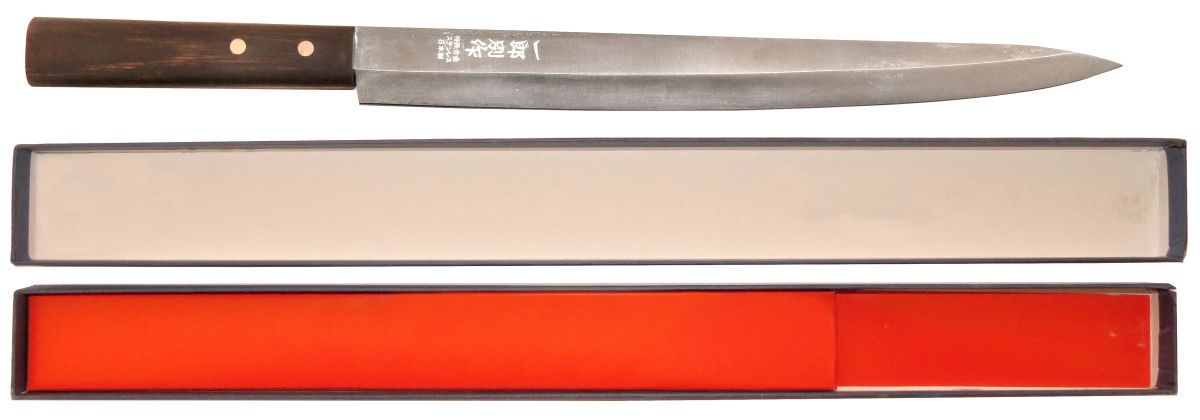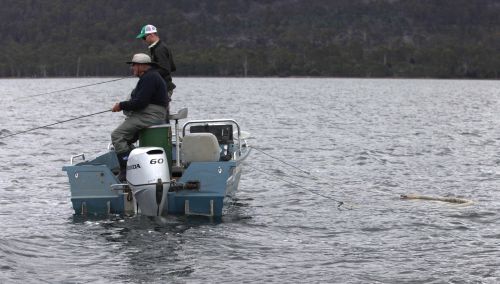From the Archives ...
Sea Run Trout
Mid Sea-Run Season Report
Sea-run trout fishing this year got off to a cracking start in most areas, with the majority of anglers employing nearly every trout fishing technique to secure fish in local estuaries statewide.
Even those anglers fishing the "off-season" lower down in our estuaries for sea-trout commented on the number of fish moving in early August.
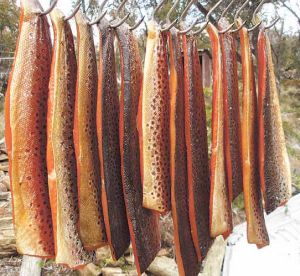 Presented from Issue 109, April 2014
Presented from Issue 109, April 2014
It is that time of the year when there is a freezer full of trout. For some that is true, others not. Arthurs anglers have caught plenty, but often they are small, however the condition has been great and the colour of the flesh is extraordinary.
Many other lakes have seen the fish in excellent condition. Woods, Tooms, Leake and any lake with good shrimp populations have these lovely coloured fish.
- Written by Stephen Smith - Rubicon Web and Technology Training
- Category: Cooking Fish
- Hits: 7686
Read more: Cold smoking - Gourmet delights made easy - Mike Stevens
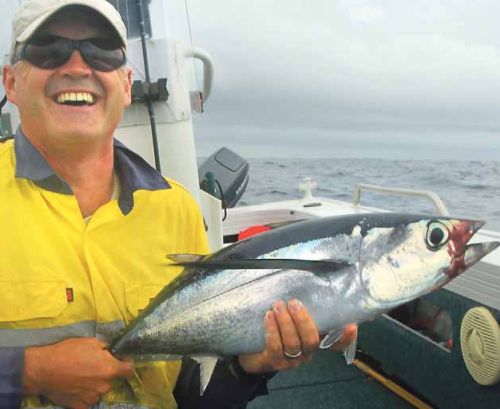 Presented from Issue 103, April 2013
Presented from Issue 103, April 2013
The day dawned overcast, grey and warm with just the hint of a northeaster wafting through. We delayed our arrival at the ramp to allow the post-competition flotilla to depart, launching the boat around 8:30. As we rounded St Helens Point we started to push into a moderate, south-east swell making our way out to the 100 metre line, the point we would start trawling. After dropping back a green and yellow skirt and a Mackbait on two old Penn 330s loaded with 15kg fireline, a third rod was a 6kg spinning outfit with a green and yellow feather jig set well back on the port side. With this spread we proceeded to trawl towards the shelf.
- Written by Stephen Smith - Rubicon Web and Technology Training
- Category: Cooking Fish
- Hits: 8436
Presented from Issue 100
Most of us have learned the various basic fish cleaning techniques passed down over the years. I am always on the lookout for faster and better methods and have picked up a few that I will describe in detail in this article. Once you have practised them I,m sure you will use some of these new methods in preference to your old ways.
- Written by Stephen Smith - Rubicon Web and Technology Training
- Category: Cooking Fish
- Hits: 12527
Read more: Cleaning your catch - New techniques to try - Shane Flude
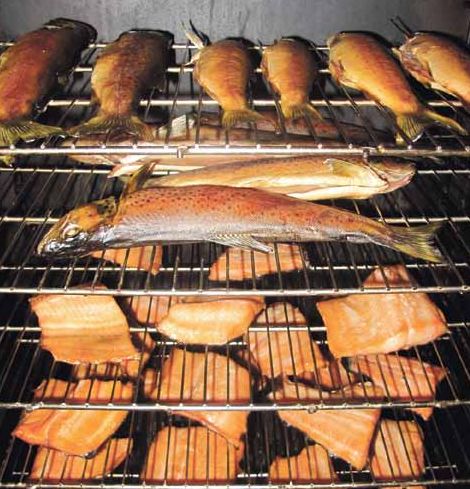 Presented from Issue 99
Presented from Issue 99
I have been smoking fish since I was a child. My European background meant that I learned these skills from an early age, from my father. Using a homemade wood-fired hot smoker, we would smoke eels predominantly, but sometimes trout too. My ‘backyard fish smoking’ apprenticeship lasted for years; however, when I was 12 years old, my father was finally happy to leave me in charge of the whole process.
To this day, I have maintained a keen interest in smoking fish. The only difference is that now, given my keen interest in fishing for them, I primarily smoke trout. Over the years, I have made several homemade fish smokers, and have smoked a variety of fish. In the early days, I stuck religiously to the traditional salt plus water brine; however, in more recent years, I have been experimenting with lots of different brine recipes.
Part of the secret to getting any smoked fish right is the brine. It is the first part of the ‘preserving’ or ‘curing’ process and is a crucial step that cannot be overlooked. Realistically, a simple mix of salt plus water is all that is required to make a basic brine solution. However, there are better recipes out there for those who want to go a step further and make something really special!
- Written by Stephen Smith - Rubicon Web and Technology Training
- Category: Cooking Fish
- Hits: 13302
Presented from Issue 98
Preparation Time: 10 minutes
Cooking Time: 4 minutes
Ingredients (serves 4 entree)
- 3 (about 600g) large cleaned squid hoods
- 1L (4 cups) vegetable oil
- 40g (1/4 cup) plain flour
- 1 tsp salt
- 1 tsp ground white pepper
- 1 tsp Chinese five-spice
- 1/2 tsp chilli powder
- Lemon wedges and soy sauce with sliced fresh red chilli, to serve
- Written by Stephen Smith - Rubicon Web and Technology Training
- Category: Cooking Fish
- Hits: 5720
by Jamie Henderson - Presented from Issue 91
In my younger days I guess I never really understood the true significance of smoke flavoured food and smoked products. I ate Bacon and Ham readily without a single thought of how that magical taste was produced, as I grew older smoked onion soup, smoked Trout and Salmon and various other smoked goods found their place upon my plate. All the while I was enjoying the flavours and taste of the products but not really thinking too hard about how it was made.
- Written by Stephen Smith - Rubicon Web and Technology Training
- Category: Cooking Fish
- Hits: 7333
by Jamie Henderson - Presented from Issue 92
In this article I will unlock the mysteries surrounding the secret to creating some of the best tasting smoked foods you could possibly achieve in your own backyard and which can often rival some of the best commercially produced products available.
- Written by Stephen Smith - Rubicon Web and Technology Training
- Category: Cooking Fish
- Hits: 7509
Yanagiba Sashimi Knives
In Japan, preparing sushi and sashimi is very serious business. One of the most important requirements is that sliced meat be smooth, shiny and sharp when viewed through a microscope. This kind of precision can only be accomplished with a special knife like a Yanagiba.
The Yanagiba is a long, very thin, single beveled (usually on the right side) sushi knife used in preparing sashimi and sushi. For lefties a left hand version can be obtained that are beveled on the left side, but they are often much more expensive.
- Written by Stephen Smith - Rubicon Web and Technology Training
- Category: Cooking Fish
- Hits: 7196
Sashimi - a heavenly slice
Mike Stevens
Sushi and Sashimi are one of the mainstay meals in the varied fare available from the many multi cultural restaurants around Australia. These simple dishes have a strikingly attractive presentation and have delicate, rich and sometimes robust taste making them a very popular meal at Japanese restaurants and every upmarket cafe in town. While these delicacies may command a high price at exclusive restaurants you can prepare sashimi and sushi at home for a pittance, and with the abundance of fresh fish available around Tasmania in both salt and fresh water you can serve a sushi meal that any restaurant in Japan would be envious of.
- Category: Cooking Fish
- Hits: 10444
Sarah's Kitchen
Sarah Sherriff
This is something that is just a little bit different but has lots of flavour.
Smoked Trout (using a hot smoker)
- Category: Cooking Fish
- Hits: 7287
Current TFBN
Click above for current issue content. The current issue of TFBN is extensive and topical. In Tackle Stores, Newsagents and by subscription.
Delivered to your door for $48 for 2 years (8 issues). To subscribe, send Mike $48 via www.paypal.com.au . (Basic instructions are here) The email is at Contact Us. Your address will be included from PayPal.
Or phone Mike with your c/c handy on 0418129949
Please ensure your details are correct, for Mike to organise delivery.
TFBN Newsletter Sign up Form
Why not submit an article ?
When you have finished for the day, why not have a brag about the ones that didn't get away! Send Mike an article on your fishing (Click here for contact details), and we'll get it published here. Have fun fishing - tasfish.com
Category Descriptions
Here is a list of all of the Article Categories. The number in Brackets, eg (13) is the number of articles. Click on Derwent River and all articles relating to the Derwent will be displayed in the central area.
Articles by Category
-
Rivers (3)
-
Saltwater and Estuary Fishing (149)
-
Kayak Fishing (34)
-
Lakes (1)
-
Great Lake (62)
-
Lake Leake (52)
-
Woods Lake (16)
-
Lake Augusta (11)
-
Huntsman Lake (13)
-
Lake Pedder and Gordon (10)
-
Lake Dulverton (5)
-
Lake Crescent (6)
-
Tooms Lake (10)
-
Lake Mackintosh (2)
-
Lake Barrington (5)
-
Little Lake (8)
-
Meadowbank Lake (5)
-
Lake King William (7)
-
Lake St Clair (2)
-
Western Lakes (12)
-
Arthurs Lake (35)
-
Lake Echo (7)
-
Four Springs (54)
-
Lake Sorell (7)
-
Lake Burbury (6)
-
Other Lakes (57)
-
Brushy Lagoon (18)
-
Little Pine Lagoon (5)
-
Penstock Lagoon (16)
-
Brumbys Creek (7)
-
-
Events (48)
-
Estuary Fishing (0)
-
Coastal Catches (46)
-
Super Trawler (46)
-
IFS, DPIPWE, MAST and Peak Bodies (435)
-
Commercial Interests (98)
-
Other (24)
-
TFBN Back Issues (8)
-
Fly Fishing (67)
-
Trout Fishing (252)
-
Meteorology and Weather (8)
-
Jan’s Flies (50)
-
Tuna Fishing and other Game Fishing (86)
-
Cooking Fish (19)
-
Fishing Information (1)
-
Fishing Books (8)
-
Videos (5)
-
Tackle, Boats and other Equipment (146)
-
World Fly Fishing Championship 2019 (2)
Popular Tags
windyty.com
Visit https://www.windyty.com/
Rubicon Web and Technology Training
Hello everyone, I thought it would be a good time to introduce myself.
My name is Stephen Smith and I have been managing the website tasfish.com since May 2009.
It has been an epic journey of learning and discovery and I am indebted to Mike Stevens for his help, support and patience.
I am developing a new venture Rubicon Web and Technology Training ( www.rwtt.com.au ). The focus is two part, to develop websites for individuals and small business and to train people to effectively use technology in their everyday lives.
Please contact me via www.rwtt.com.au/contact-me/ for further information - Stephen Smith.
From the Archives ... (last chance)
Sea run trout tactics – Craig Vertigan
Sea run trout tactics – Craig Vertigan
During the trout off-season I tend to spend a bit of time chasing bream, to continue getting a fishing fix, and spend time tying flies and dreaming about the trout season to come. It’s a time to spend doing tackle maintenance, stocking up on lures and dreaming up new challenges and goals for the trout season ahead. When the new season comes around I usually spend the first few months targeting sea runners. Sea run trout are simply brown trout that spend much of there lives out to sea and come in to the estuaries for spawning and to feed on whitebait and the other small endemic fishes that spawn in late winter through spring. Mixed in with the silvery sea runners you can also expect to catch resident fish that have the typical dark colours of a normal brown trout as well as atlantic salmon in some of our estuaries that are located near salmon farm pens. Living in Hobart it is quick and easy to do a trip on the Huon or Derwent and is a more comfortable proposition compared to a trip up to the highlands with snow and freezing winds to contend with.
Read more ...
